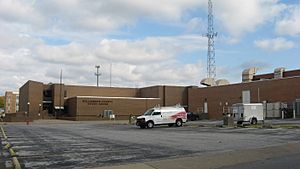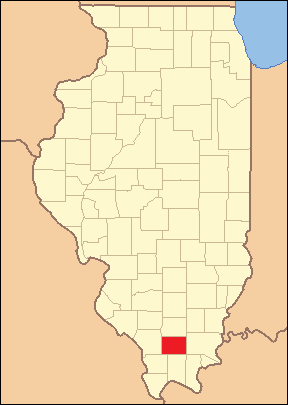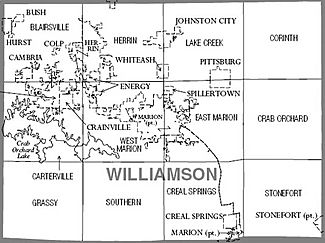Williamson County, Illinois facts for kids
Quick facts for kids
Williamson County
|
|
|---|---|

Williamson County Courthouse in Marion
|
|

Location within the U.S. state of Illinois
|
|
 Illinois's location within the U.S. |
|
| Country | |
| State | |
| Founded | February 28, 1839 |
| Named for | Williamson County, Tennessee |
| Seat | Marion |
| Largest city | Marion |
| Area | |
| • Total | 444 sq mi (1,150 km2) |
| • Land | 420 sq mi (1,100 km2) |
| • Water | 24 sq mi (60 km2) 5.4% |
| Population
(2020)
|
|
| • Total | 67,153 |
| • Density | 151.25/sq mi (58.40/km2) |
| Time zone | UTC−6 (Central) |
| • Summer (DST) | UTC−5 (CDT) |
| Congressional district | 12th |
Williamson County is a county in Southern Illinois. At the 2020 census, it had a population of 67,153. The largest city and county seat is Marion.
Williamson County is included in the Carbondale-Marion, IL Metropolitan Statistical Area. This area of Southern Illinois is known locally as "Little Egypt".
Williamson is in the Metro Lakeland area, 88 miles (142 km) southeast of St. Louis, Missouri. Via the nearby intersection of Interstates 57 and 24, and Illinois Route 13, a primary east–west four-lane expressway, the city has access to the major communities of Murphysboro, Carbondale, Carterville, Herrin, Marion and Harrisburg.
The Metro Lakeland area of Jackson-Williamson counties has a total of 120,000 residents. Carbondale (14 miles west), Herrin and Marion are the key urban areas in Metro Lakeland, with a combined population of more than 65,000. Over 235,000 people live within 35 miles (56 km).
Contents
History
Williamson County was formed from Franklin County on February 28, 1839, and was named for Williamson County, Tennessee. Many of its early settlers traveled on the Ohio River from Tennessee and Virginia.
It became a center of coal mining, attracting numerous European immigrants in the late 19th and early 20th centuries. Labor tensions rose as workers sought to unionize and improve their wages and conditions resulted in several episodes of violence. Williamson County is often referred to as "Bloody Williamson," due to several outbreaks of violence that have few parallels in American history.
These include the Bloody Vendetta (1876), armed confrontation between families and associates during the waning days of Reconstruction; the Carterville Massacre (1899), a Coal Strike (1906), the Herrin Massacre (1922), the Klan War (1924–1926), and the Birger/Shelton Gang War (1926).
Severe weather in Williamson County is not uncommon. The northwest section of the county suffered extensive damage during the Tri-State Tornado of 1925. The county was also struck by two tornadoes on May 29, 1982, which killed 10 people in the Marion, Illinois tornado outbreak. On May 8, 2009, the cities of Carterville, Herrin, and Marion were severely damaged by the May 2009 Southern Midwest derecho.
Geography
According to the U.S. Census Bureau, the county has a total area of 444 square miles (1,150 km2), of which 420 square miles (1,100 km2) is land and 24 square miles (62 km2) (5.4%) is water.
Adjacent counties
- Franklin County (north)
- Saline County (east)
- Pope County (southeast)
- Johnson County (south)
- Union County (southwest)
- Jackson County (west)
National protected area
Major highways
 Interstate 24
Interstate 24 Interstate 57
Interstate 57 U.S. Highway 45
U.S. Highway 45 Illinois Route 13
Illinois Route 13 Illinois Route 37
Illinois Route 37 Illinois Route 148
Illinois Route 148 Illinois Route 149
Illinois Route 149 Illinois Route 166
Illinois Route 166
Airport
Williamson County Regional Airport is the local airport.
Demographics
| Historical population | |||
|---|---|---|---|
| Census | Pop. | %± | |
| 1840 | 4,457 | — | |
| 1850 | 7,216 | 61.9% | |
| 1860 | 12,205 | 69.1% | |
| 1870 | 17,329 | 42.0% | |
| 1880 | 19,324 | 11.5% | |
| 1890 | 22,226 | 15.0% | |
| 1900 | 27,796 | 25.1% | |
| 1910 | 45,098 | 62.2% | |
| 1920 | 61,092 | 35.5% | |
| 1930 | 53,880 | −11.8% | |
| 1940 | 51,424 | −4.6% | |
| 1950 | 48,621 | −5.5% | |
| 1960 | 46,117 | −5.2% | |
| 1970 | 49,021 | 6.3% | |
| 1980 | 56,538 | 15.3% | |
| 1990 | 57,733 | 2.1% | |
| 2000 | 61,296 | 6.2% | |
| 2010 | 66,357 | 8.3% | |
| 2020 | 67,153 | 1.2% | |
| U.S. Decennial Census 1790-1960 1900-1990 1990-2000 2010-2013 |
|||
As of the 2010 United States Census, there were 66,357 people, 27,421 households, and 17,999 families residing in the county. The population density was 157.9 inhabitants per square mile (61.0/km2). There were 30,359 housing units at an average density of 72.3 per square mile (27.9/km2). The racial makeup of the county was 92.7% white, 3.8% black or African American, 0.8% Asian, 0.4% Native American , 0.5% from other races, and 1.7% from two or more races. Those of Hispanic or Latino origin made up 2.0% of the population. In terms of ancestry, 23.6% were German, 17.3% were Irish, 16.0% were English, 9.0% were American, and 6.1% were Italian.
Of the 27,421 households, 30.2% had children under the age of 18 living with them, 49.4% were married couples living together, 11.5% had a female householder with no husband present, 34.4% were non-families, and 29.1% of all households were made up of individuals. The average household size was 2.35 and the average family size was 2.88. The median age was 40.1 years.
The median income for a household in the county was $40,579 and the median income for a family was $50,929. Males had a median income of $41,428 versus $30,901 for females. The per capita income for the county was $22,164. About 13.3% of families and 16.7% of the population were below the poverty line, including 24.3% of those under age 18 and 9.9% of those age 65 or over.
Climate and weather
| Weather chart for Marion, Illinois | |||||||||||||||||||||||||||||||||||||||||||||||
|---|---|---|---|---|---|---|---|---|---|---|---|---|---|---|---|---|---|---|---|---|---|---|---|---|---|---|---|---|---|---|---|---|---|---|---|---|---|---|---|---|---|---|---|---|---|---|---|
| J | F | M | A | M | J | J | A | S | O | N | D | ||||||||||||||||||||||||||||||||||||
|
3.3
38
19
|
3.2
44
23
|
4.5
55
33
|
4.5
66
42
|
4.9
75
52
|
4.3
83
61
|
3.9
87
65
|
3.7
86
63
|
3.1
79
55
|
3.1
68
43
|
4.8
55
34
|
3.7
43
24
|
||||||||||||||||||||||||||||||||||||
| temperatures in °F precipitation totals in inches source: The Weather Channel |
|||||||||||||||||||||||||||||||||||||||||||||||
|
Metric conversion
|
|||||||||||||||||||||||||||||||||||||||||||||||
Williamson County lies on the border between humid continental climate (Köppen climate classification Dfa) and humid subtropical climate (Köppen climate classification Cfa), with neither large mountains nor large bodies of water to moderate its temperature. It is subject to both cold Arctic air and hot, humid tropical air from the Gulf of Mexico and, along with the rest of the midwestern United States, is home to some of the largest temperature extremes in the world. The region has four distinct seasons. Spring is the wettest season and produces erratic severe weather ranging from tornadoes to winter storms. Summers are hot and humid with only occasional and brief respite, and the humidity often makes the heat index rise to temperatures feeling well above 100 °F (38 °C). Fall is mild with lower humidity and can produce intermittent bouts of heavy rainfall with the first snow flurries usually forming in late November. Winters are cold with periodic snow and temperatures often below freezing; however, thaws are usually frequent. Winter storm systems, such as Alberta clippers and Panhandle hooks, can bring days of heavy freezing rain, ice pellets, and snowfall.
The normal high temperature in July is 90 °F (32 °C), and the normal low temperature in January is 19 °F (−6 °C), although this varies from year to year. Both 100 °F (37.8 °C) and 0 °F (−17.8 °C) temperatures can be seen on an average 2 or 3 days per year. In recent years, average temperatures have ranged from a low of 19 °F (−7 °C) in January to a high of 88 °F (31 °C) in July, although a record low of −25 °F (−32 °C) was recorded in January 1977 and a record high of 113 °F (45 °C) was recorded in August 1977. Average monthly precipitation ranged from 3.06 inches (78 mm) in October to 4.93 inches (125 mm) in May.
Williamson County experiences thunderstorms about 50 days a year on average. Thunderstorms contribute over half of the annual precipitation. Especially in the spring, these storms can often be severe, with high winds, large hail and tornadoes.
Some late autumns feature the warm weather known as Indian summer; some years see roses in bloom as late as early December.
Communities
Cities
Villages
Census-designated places
Other unincorporated communities
- Corinth
- Crenshaw
- Dewmaine
- Dykersburg
- Lake of Egypt
- No. 9
- Paulton
- Pulleys Mill
Ghost towns
Precincts
The following precincts are not voting precincts, but represent the 12 Congressional townships in Williamson County. Most have multiple voting precincts.
See also
 In Spanish: Condado de Williamson (Illinois) para niños
In Spanish: Condado de Williamson (Illinois) para niños



